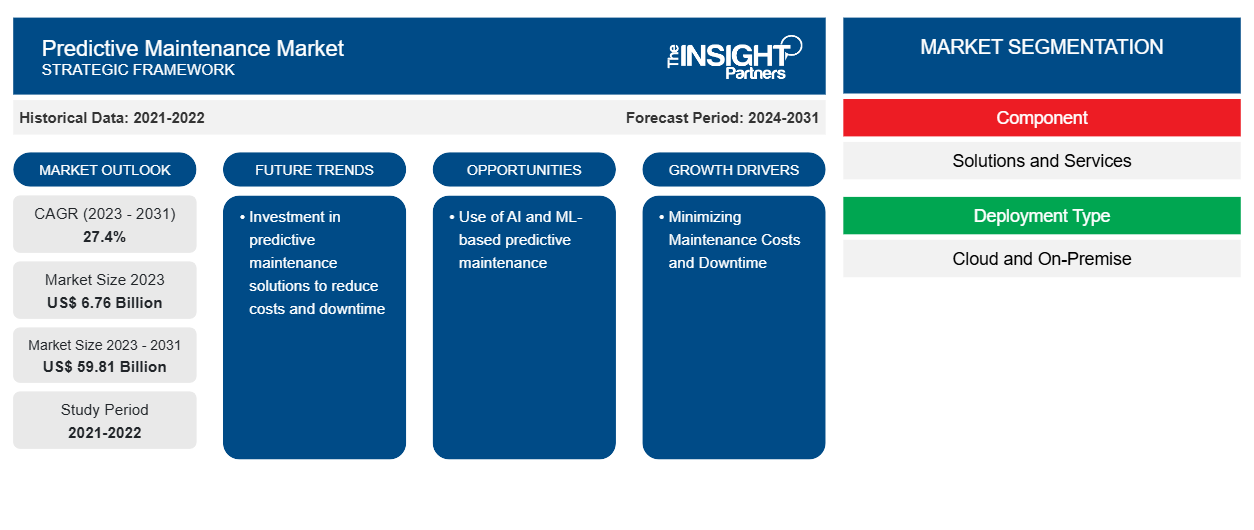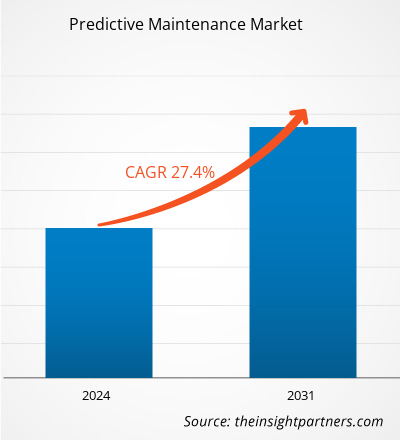The predictive maintenance market size is projected to reach US$ 59.81 billion by 2031 from US$ 6.76 billion in 2023. The market is expected to register a CAGR of 27.4% during 2023–2031. The investment in predictive maintenance solutions to reduce costs and downtime is likely to remain a key trend in the market.
Predictive Maintenance Market Analysis
In recent decades, the high demand to reduce increasingly expensive energy costs and shift toward a sustainable future have made energy audits important. As energy expenditure is a major concern for industries, companies are continuously checking energy consumption and significantly aiming to minimize it.
Predictive Maintenance Market Overview
Predictive maintenance improves equipment performance by merging Internet of Things sensors, artificial intelligence, and data science. It entails employing cloud-enabled technology to monitor and estimate maintenance requirements based on asset status, as well as identifying abnormalities that might lead to unexpected breakdowns. As a consequence, manufacturers profit significantly from forecasting equipment maintenance requirements in order to save costs and increase uptime. The core approach used to monitor industrial assets in real time is Condition Based Monitoring. Advanced IIoT sensors record complicated machine health data such as vibration, acoustics, temperature, and RPM, among others. The collected data is then evaluated to identify any variances in asset performance or problems that would be hard to detect with traditional equipment.
Customize This Report To Suit Your Requirement
You will get customization on any report - free of charge - including parts of this report, or country-level analysis, Excel Data pack, as well as avail great offers and discounts for start-ups & universities
Predictive Maintenance Market: Strategic Insights

-
Get Top Key Market Trends of this report.This FREE sample will include data analysis, ranging from market trends to estimates and forecasts.
Predictive Maintenance Market Drivers and Opportunities
Minimizing Maintenance Costs and Downtime to Favor Market
Organizations now face an increasing desire to reduce maintenance expenses, equipment failures, and downtimes. Predictive maintenance is an excellent method for addressing these difficulties. Predictive maintenance systems use data analytics and machine learning to identify possible flaws in equipment before they occur, allowing for proactive maintenance interventions. Predicting equipment breakdowns early allows firms to arrange repair during planned downtime, reducing interruptions to operations and maximizing equipment uptime.
Use of AI and ML-based predictive maintenance
AI-based predictive maintenance has a wide range of applications in manufacturing. It employs powerful machine learning algorithms to evaluate huge amounts of data collected during production, providing key insights into achieving manufacturing excellence. In addition, machine learning algorithms utilize massive amounts of historical data to simulate various situations and predict what will go wrong and when. Advanced artificial intelligence algorithms recognize a machine's typical data behavior and use it as a baseline to detect and warn of variations in real-time.
Predictive Maintenance Market Report Segmentation Analysis
Key segments that contributed to the derivation of the predictive maintenance market analysis are component, deployment type, technique and industry.
- Based on component, the market is segmented by solutions and services. The solutions segment held a significant market share in 2023.
- Based on deployment type, the market is segmented into cloud and on-premises. The cloud segment held the largest share of the market in 2023.
- Based on technique, the market is segmented into vibration monitoring, electrical testing, oil analysis, ultrasonic leak detectors, shock pulse, infrared and others. The vibration monitoring segment held the largest share of the market in 2023.
- Based on industry, the market is segmented into manufacturing, energy & utilities, aerospace & defense, transportation & logistics, oil & gas, and others. The manufacturing segment held the largest share of the market in 2023.
Predictive Maintenance Market Share Analysis by Geography
The geographic scope of the predictive maintenance market report is mainly divided into five regions: North America, Asia Pacific, Europe, Middle East & Africa, and South & Central America.
North America dominated the market in 2023. The use of modern technologies such as Machine Learning (ML), acoustic monitoring, Artificial Intelligence (AI), and the Internet of Things (IoT), as well as the expansion of customer channels and growing concerns about asset maintenance and operating expenses, have all contributed to growth. Furthermore, the adoption of IoT-connected devices in consumer electronics and M2M applications, rising demand for connected automobiles in the automotive industry, and a growing desire for innovative consumer electronics are propelling market expansion.
Predictive Maintenance Market Regional InsightsThe regional trends and factors influencing the Predictive Maintenance Market throughout the forecast period have been thoroughly explained by the analysts at The Insight Partners. This section also discusses Predictive Maintenance Market segments and geography across North America, Europe, Asia Pacific, Middle East and Africa, and South and Central America.
Predictive Maintenance Market Report Scope
| Report Attribute | Details |
|---|---|
| Market size in 2023 | US$ 6.76 Billion |
| Market Size by 2031 | US$ 59.81 Billion |
| Global CAGR (2023 - 2031) | 27.4% |
| Historical Data | 2021-2022 |
| Forecast period | 2024-2031 |
| Segments Covered |
By Component
|
| Regions and Countries Covered |
North America
|
| Market leaders and key company profiles |
|
Predictive Maintenance Market Players Density: Understanding Its Impact on Business Dynamics
The Predictive Maintenance Market is growing rapidly, driven by increasing end-user demand due to factors such as evolving consumer preferences, technological advancements, and greater awareness of the product's benefits. As demand rises, businesses are expanding their offerings, innovating to meet consumer needs, and capitalizing on emerging trends, which further fuels market growth.

- Get the Predictive Maintenance Market top key players overview
Predictive Maintenance Market News and Recent Developments
The predictive maintenance market is evaluated by gathering qualitative and quantitative data post primary and secondary research, which includes important corporate publications, association data, and databases. A few of the developments in the predictive maintenance market are listed below:
- Accenture plc acquired Nextira, an Amazon Web Services (AWS) Premier Partner that uses AWS services to provide predictive analytics, cloud-native innovations, and an immersive experience to its clients. These AWS services and solutions enable Accenture Cloud First to improve its technical skills while also providing clients with full-scale cloud capabilities. Nextira provides cloud-based services that use cutting-edge artificial intelligence, machine learning, engineering expertise, and data analytics to help users construct, design, launch, and optimize high-performance computing environments. (Source: Accenture plc, Press Release, June 2023)
- GE Vernova’s Gas Power business announced it has signed a multi-year agreement for an 876-megawatt (MW) plant in Al Ahmadi, Kuwait. Multi-year agreement includes the supply of parts, repairs, field services, advanced predictive maintenance, and digital solutions. (Source: GE Vernova, Press Release, December 2023)
Predictive Maintenance Market Report Coverage and Deliverables
The “Predictive Maintenance Market Size and Forecast (2021–2031)” report provides a detailed analysis of the market covering below areas:
- Predictive Maintenance market size and forecast at global, regional, and country levels for all the key market segments covered under the scope
- Predictive Maintenance market trends as well as market dynamics such as drivers, restraints, and key opportunities
- Detailed PEST/Porter’s Five Forces and SWOT analysis
- Predictive Maintenance market analysis covering key market trends, global and regional framework, major players, regulations, and recent market developments
- Industry landscape and competition analysis covering market concentration, heat map analysis, prominent players, and recent developments for the superconductor market
- Detailed company profiles
Frequently Asked Questions
What are the driving factors impacting the predictive maintenance market?
Which region dominated the Predictive maintenance market in 2023?
What are the future trends of the predictive maintenance market?
Which are the leading players operating in the Predictive Maintenance market?
What would be the estimated value of the predictive maintenance market by 2031?
What is the expected CAGR of the predictive maintenance market?
- Historical Analysis (2 Years), Base Year, Forecast (7 Years) with CAGR
- PEST and SWOT Analysis
- Market Size Value / Volume - Global, Regional, Country
- Industry and Competitive Landscape
- Excel Dataset
Recent Reports
Testimonials
Reason to Buy
- Informed Decision-Making
- Understanding Market Dynamics
- Competitive Analysis
- Identifying Emerging Markets
- Customer Insights
- Market Forecasts
- Risk Mitigation
- Boosting Operational Efficiency
- Strategic Planning
- Investment Justification
- Tracking Industry Innovations
- Aligning with Regulatory Trends





















 Get Free Sample For
Get Free Sample For